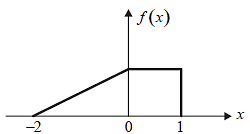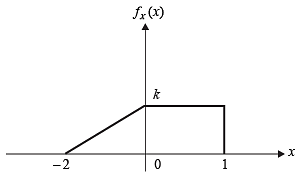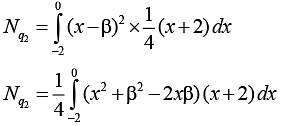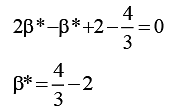Electronics and Communication Engineering (ECE) Exam > Electronics and Communication Engineering (ECE) Questions > Consider a real valued source whose samples ...
Start Learning for Free
Consider a real valued source whose samples are independent and identically distributed random variables with the probability density function, f(x), as shown in the figure.

Consider a 1-bit quantizer that maps positive samples to value α and others to value β . If a* and b* are the respective choices for α and β that minimize the mean square quantization error, then (α* - β*) = _____. (round off to two decimal places)
- a)1.15
- b)1.18
Correct answer is between '1.15,1.18'. Can you explain this answer?
| FREE This question is part of | Download PDF Attempt this Test |
Most Upvoted Answer
Consider a real valued source whose samples are independent and ident...
Given probability density function can be drawn as shown below,


















As area under probability density function is 1.

Function fx(x) can defined as,

Given quantized values are,

For 0 ≤ x ≤ 1,
Mean square quantization error will be,






3(α*)2 = 3(1 - α*)2
(α*)2 = (1 - α*)2
(α*) = 1- α*
2α* =1
α* = 1/2 = 0.5
For -2 ≤ x ≤ 0 ,
Mean square quantization error will be,








∴ α*- β* = 0.5 + 0.66 =1.16
Hence, the correct answer is 1.16.
Free Test
FREE
| Start Free Test |
Community Answer
Consider a real valued source whose samples are independent and ident...
Given probability density function can be drawn as shown below,


















As area under probability density function is 1.

Function fx(x) can defined as,

Given quantized values are,

For 0 ≤ x ≤ 1,
Mean square quantization error will be,






3(α*)2 = 3(1 - α*)2
(α*)2 = (1 - α*)2
(α*) = 1- α*
2α* =1
α* = 1/2 = 0.5
For -2 ≤ x ≤ 0 ,
Mean square quantization error will be,








∴ α*- β* = 0.5 + 0.66 =1.16
Hence, the correct answer is 1.16.
Attention Electronics and Communication Engineering (ECE) Students!
To make sure you are not studying endlessly, EduRev has designed Electronics and Communication Engineering (ECE) study material, with Structured Courses, Videos, & Test Series. Plus get personalized analysis, doubt solving and improvement plans to achieve a great score in Electronics and Communication Engineering (ECE).

|
Explore Courses for Electronics and Communication Engineering (ECE) exam
|

|
Similar Electronics and Communication Engineering (ECE) Doubts
Consider a real valued source whose samples are independent and identically distributed random variables with the probability density function, f(x), as shown in the figure.Consider a 1-bit quantizer that maps positive samples to value α and others to value β . If a* and b* are the respective choices for α and β that minimize the mean square quantization error, then (α* - β*) = _____. (round off to two decimal places)a)1.15b)1.18Correct answer is between '1.15,1.18'. Can you explain this answer?
Question Description
Consider a real valued source whose samples are independent and identically distributed random variables with the probability density function, f(x), as shown in the figure.Consider a 1-bit quantizer that maps positive samples to value α and others to value β . If a* and b* are the respective choices for α and β that minimize the mean square quantization error, then (α* - β*) = _____. (round off to two decimal places)a)1.15b)1.18Correct answer is between '1.15,1.18'. Can you explain this answer? for Electronics and Communication Engineering (ECE) 2024 is part of Electronics and Communication Engineering (ECE) preparation. The Question and answers have been prepared according to the Electronics and Communication Engineering (ECE) exam syllabus. Information about Consider a real valued source whose samples are independent and identically distributed random variables with the probability density function, f(x), as shown in the figure.Consider a 1-bit quantizer that maps positive samples to value α and others to value β . If a* and b* are the respective choices for α and β that minimize the mean square quantization error, then (α* - β*) = _____. (round off to two decimal places)a)1.15b)1.18Correct answer is between '1.15,1.18'. Can you explain this answer? covers all topics & solutions for Electronics and Communication Engineering (ECE) 2024 Exam. Find important definitions, questions, meanings, examples, exercises and tests below for Consider a real valued source whose samples are independent and identically distributed random variables with the probability density function, f(x), as shown in the figure.Consider a 1-bit quantizer that maps positive samples to value α and others to value β . If a* and b* are the respective choices for α and β that minimize the mean square quantization error, then (α* - β*) = _____. (round off to two decimal places)a)1.15b)1.18Correct answer is between '1.15,1.18'. Can you explain this answer?.
Consider a real valued source whose samples are independent and identically distributed random variables with the probability density function, f(x), as shown in the figure.Consider a 1-bit quantizer that maps positive samples to value α and others to value β . If a* and b* are the respective choices for α and β that minimize the mean square quantization error, then (α* - β*) = _____. (round off to two decimal places)a)1.15b)1.18Correct answer is between '1.15,1.18'. Can you explain this answer? for Electronics and Communication Engineering (ECE) 2024 is part of Electronics and Communication Engineering (ECE) preparation. The Question and answers have been prepared according to the Electronics and Communication Engineering (ECE) exam syllabus. Information about Consider a real valued source whose samples are independent and identically distributed random variables with the probability density function, f(x), as shown in the figure.Consider a 1-bit quantizer that maps positive samples to value α and others to value β . If a* and b* are the respective choices for α and β that minimize the mean square quantization error, then (α* - β*) = _____. (round off to two decimal places)a)1.15b)1.18Correct answer is between '1.15,1.18'. Can you explain this answer? covers all topics & solutions for Electronics and Communication Engineering (ECE) 2024 Exam. Find important definitions, questions, meanings, examples, exercises and tests below for Consider a real valued source whose samples are independent and identically distributed random variables with the probability density function, f(x), as shown in the figure.Consider a 1-bit quantizer that maps positive samples to value α and others to value β . If a* and b* are the respective choices for α and β that minimize the mean square quantization error, then (α* - β*) = _____. (round off to two decimal places)a)1.15b)1.18Correct answer is between '1.15,1.18'. Can you explain this answer?.
Solutions for Consider a real valued source whose samples are independent and identically distributed random variables with the probability density function, f(x), as shown in the figure.Consider a 1-bit quantizer that maps positive samples to value α and others to value β . If a* and b* are the respective choices for α and β that minimize the mean square quantization error, then (α* - β*) = _____. (round off to two decimal places)a)1.15b)1.18Correct answer is between '1.15,1.18'. Can you explain this answer? in English & in Hindi are available as part of our courses for Electronics and Communication Engineering (ECE).
Download more important topics, notes, lectures and mock test series for Electronics and Communication Engineering (ECE) Exam by signing up for free.
Here you can find the meaning of Consider a real valued source whose samples are independent and identically distributed random variables with the probability density function, f(x), as shown in the figure.Consider a 1-bit quantizer that maps positive samples to value α and others to value β . If a* and b* are the respective choices for α and β that minimize the mean square quantization error, then (α* - β*) = _____. (round off to two decimal places)a)1.15b)1.18Correct answer is between '1.15,1.18'. Can you explain this answer? defined & explained in the simplest way possible. Besides giving the explanation of
Consider a real valued source whose samples are independent and identically distributed random variables with the probability density function, f(x), as shown in the figure.Consider a 1-bit quantizer that maps positive samples to value α and others to value β . If a* and b* are the respective choices for α and β that minimize the mean square quantization error, then (α* - β*) = _____. (round off to two decimal places)a)1.15b)1.18Correct answer is between '1.15,1.18'. Can you explain this answer?, a detailed solution for Consider a real valued source whose samples are independent and identically distributed random variables with the probability density function, f(x), as shown in the figure.Consider a 1-bit quantizer that maps positive samples to value α and others to value β . If a* and b* are the respective choices for α and β that minimize the mean square quantization error, then (α* - β*) = _____. (round off to two decimal places)a)1.15b)1.18Correct answer is between '1.15,1.18'. Can you explain this answer? has been provided alongside types of Consider a real valued source whose samples are independent and identically distributed random variables with the probability density function, f(x), as shown in the figure.Consider a 1-bit quantizer that maps positive samples to value α and others to value β . If a* and b* are the respective choices for α and β that minimize the mean square quantization error, then (α* - β*) = _____. (round off to two decimal places)a)1.15b)1.18Correct answer is between '1.15,1.18'. Can you explain this answer? theory, EduRev gives you an
ample number of questions to practice Consider a real valued source whose samples are independent and identically distributed random variables with the probability density function, f(x), as shown in the figure.Consider a 1-bit quantizer that maps positive samples to value α and others to value β . If a* and b* are the respective choices for α and β that minimize the mean square quantization error, then (α* - β*) = _____. (round off to two decimal places)a)1.15b)1.18Correct answer is between '1.15,1.18'. Can you explain this answer? tests, examples and also practice Electronics and Communication Engineering (ECE) tests.

|
Explore Courses for Electronics and Communication Engineering (ECE) exam
|

|
Suggested Free Tests
Signup for Free!
Signup to see your scores go up within 7 days! Learn & Practice with 1000+ FREE Notes, Videos & Tests.
























